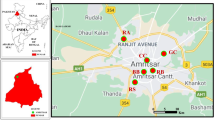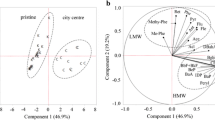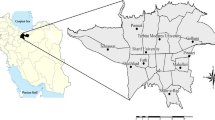Abstract
Preliminary analysis was performed to assess human health risks of exposure to 16 polycyclic aromatic hydrocarbons (PAHs) by way of inhalation by children and adults living in urban area of Amritsar, Punjab, India. In particular, the United States Environmental Protection Agency’s (USEPA’s) 16 priority PAH compounds were analyzed in air particulate matter (PM10) from different geographical locations by high-volume air sampler. Sum concentrations of PAHs (37–274 ng m−3) were comparable with those of other cities in India as well many cities on a global scale. Pyrene, naphthalene, acenaphthene, acenaphthylene, fluoranthene, fluorene, and dibenzo(a,h)anthracene accounted for >80 % of ∑16PAH concentrations. Furthermore, the contribution of seven carcinogenic PAHs accounted for 12 % of ∑16PAHs. The estimated carcinogenicity of PAHs in terms of benzo(a)pyrene toxic equivalency (BaPTEQ) was assessed and confirmed that dibenzo(a,h)anthracene was the dominant PAH contributor (88.7 %) followed by benzo(a)pyrene (6.67 %). Homolog pattern and diagnostic ratios of PAHs suggested that mixed pyrogenic sources—including biomass burning, coal combustion, and petrogenic sources, such as vehicular emissions—are dominant PAH sources in Amritsar. Health risk of adults and children by way of PAHs was assessed by estimating the lifetime average daily dose (LADD) and corresponding incremental lifetime cancer risk (ILCR) using USEPA guidelines. The assessed cancer risk (ILCR) was found to be within the acceptable range (10−6–10−4).


Similar content being viewed by others
References
Abba EJ, Unnikrishnan S, Kumar R, Yeole B, Chowdhury Z (2012) Fine aerosol and PAH carcinogenicity estimation in outdoor environment of Mumbai City, India. Int J Environ Health Res 22:134–149
Agency for Toxic Substances and Disease Registry (1990) Polynuclear aromatic hydrocarbon (PAH) toxicity. Case studies in environmental health medicine #13. United States Department of Health and Human Services
Akyuz M, Cabuk H (2009) Meteorological variations of PM2.5/PM10 concentrations and particle-associated polycyclic aromatic hydrocarbons in the atmospheric environment of Zonguldak, Turkey. J Hazard Mater 170:13–21
Asante-Duah K (2002) Public health risk assessment for human exposure to chemicals. Kluwer, Dordrecht
ATSDR (1995) Toxicological profile for polycyclic aromatic hydrocarbons (PAHs). United States Department of Health and Human Services, Public Health Service. Atlanta, GA. http://www.atdsr.cdc.gov/toxpro.les/phs69. Accessed March 2013
Bai Z, Hu Y, Yu H, Wu N, You Y (2009) Quantitative health risk assessment of inhalation exposure to polycyclic aromatic hydrocarbons on citizens in Tianjin, China. Bull Environ Contam Toxicol 83:151–154
Bosetti C, Boffetta P, La Vecchia C (2007) Occupational exposures to polycyclic aromatic hydrocarbons, and respiratory and urinary tract cancers: A quantitative review to 2005. Ann Oncol 18:431–446
Bostrom CE, Gerde P, Hanberg A, Jernstrom B, Johansson C, Kyrklund T et al (2002) Cancer risk assessment, indicators, and guidelines for polycyclic aromatic hydrocarbons in the ambient air. Environ Health Perspect 110:451–488
Callen MS, de la Cruz MT, Lopez JM, Murillo R, Navarro MV, Mastral AM (2008) Long-range atmospheric transport and local pollution sources on PAH concentrations in a South European urban area. Fulfilling of the European directive. Water Air Soil Pollut 190:271–285
Caricchia AM, Chiavarini S, Pezza M (1999) Polycyclic aromatic hydrocarbons in the urban atmospheric particulate matter in the city of Naples (Italy). Atmos Environ 33:3731–3738
Chen S, Liao C (2006) Health risk assessment on human exposed to environmental polycyclic aromatic hydrocarbons pollution sources. Sci Total Environ 366:112–123
Chen YG, Sheng GY, Bi XH (2005) Emission factors for carbonaceous particles and polycyclic aromatic hydrocarbons from residential coal combustion in China. Environ Sci Technol 39:1861–1867
Chen Y, Feng Y, Xiong S, Liu D, Wang G, Sheng G, Fu J (2011) Polycyclic aromatic hydrocarbons in the atmosphere of Shanghai, China. Environ Monit Assess 172:235–247
Cheng Y, Ho KF, Wu WJ, Ho SSH, Lee SC, Huang Y et al (2012) Real-time characterization of particle-bound polycyclic aromatic hydrocarbons at a heavily trafficked roadside site. Aerosol Air Qual Res 12:1181–1188
Chiang KC, Chio CP, Chiang YH, Liao CM (2009) Assessing hazardous risks of human exposure to temple airborne polycyclic aromatic hydrocarbons. J Hazard Mater 166:676–685
Dickhut RM, Canuel EA, Gustafson KE, Liu K, Arzayus KM, Walker SE et al (2000) Automotive sources of carcinogenic polycyclic aromatic hydrocarbons associated with particulate matter in the Chesapeake Bay Region. Environ Sci Technol 34:4635–4640
Ding X, Wang XM, Xie ZQ, Xiang CH, Mai BX, Sun LG (2007) Atmospheric polycyclic aromatic hydrocarbons observed over the North Pacific Ocean and the Arctic area: spatial distribution and source identification. Atmos Environ 47:2061–2072
European Commission (2004) European Commission directive 2004/107/EC of the European Parliament and of the Council of 15 December 2004 relating to arsenic, cadmium, mercury, nickel and PAH in ambient air. Off J Eur Union 26:3–16
Fang GC, Wu YS, Chen MH, Ho TT, Huang SH, Rau JJY (2004) Polycyclic aromatic hydrocarbons study in Taichung, Taiwan, during 2002–2003. Atmos Environ 38:3385–3391
Furuuchi M, Murase T, Tsukawaki S, Hang P, Sieng S, Hata M (2007) Characteristics of ambient particle-bound polycyclic aromatic hydrocarbons in the Angkor monument area of Cambodia. Aerosol Air Qual Res 7:221–238
Gaspari L, Chang SS, Santella RM, Garte S, Pedotti P, Taioli E (2003) Polycyclic aromatic hydrocarbon-DNA adducts in human sperm as marker of DNA damage and infertility. Mutat Res 535:155–160
Guo Y, Senthilkumar K, Alomirah H, Moon HB, Minh TB, Mohd MA et al (2013) Concentrations and profiles of urinary polycyclic aromatic hydrocarbon metabolites (OH-PAHs) in several Asian countries. Environ Sci Technol 47(6):2932–2938
Gupta S, Kumar K, Srivastava A, Srivastava A, Jain VK (2011) Size distribution and source apportionment of polycyclic aromatic hydrocarbons (PAHs) in aerosol particle samples from the atmospheric environment of Delhi, India. Sci Total Environ 409:4674–4680
Hassan SK, Khoder MI (2012) Gas-particle concentration, distribution, and health risk assessment of polycyclic aromatic hydrocarbons at a traffic area of Giza, Egypt. Environ Monit Assess 184:3593–3612
International Agency for Research on Cancer (2006) Polycyclic aromatic hydrocarbons, IARC monogaraph 92, Lyone, France. http://monographs.iarc.fr/ENG/Meetings/92-pahs.pdf. Accessed March 2013
Kamboj SS, Sambyal V (2006) Increased chromosomal aberrations in peripheral blood lymphocytes of traffic policemen of Amritsar City. Int J Hum Genet 6:125–131
Kavouras JG, Koutrakis P, Tsapakis M, Lagoudaki E, Stephanou EG, Von Baer D et al (2001) Source apportionment of urban particulate aliphatic and polynuclear aromatic hydrocarbons (PAHs) using multivariate methods. Environ Sci Technol 35:2288–2294
Khaiwal R, Bencs L, Wauters E, de Hoog J, Deutsch F, Roekens E et al (2006) Seasonal and site-specific variation in vapour and aerosol phase PAHs over Flanders (Belgium) and their relation with anthropogenic activities. Atmos Environ 40:771–785
Khalili NR, Scheff PA, Holsen TM (1995) PAH source fingerprints for coke ovens, diesel and gasoline engines, highway tunnels, and wood combustion emissions. Atmos Environ 4:533–542
Lee WJ, Wang YF, Lin TC, Chen YY, Lin WC, Ku CC et al (1995) PAH characteristics in the ambient air of traffic-source. Sci Total Environ 159:185–200
Li R, Ning Z, Majumdar R, Cui J, Takabe W, Jen N et al (2010) Ultrafine particles from diesel vehicle emissions at different driving cycles induce differential vascular pro-inflammatory responses: implication of chemical components and NF-κB signalling. Part Fibre Toxicol 7:6–15
Marr LC, Kirchstetter TW, Harley RA (1999) Characterization of polycyclic aromatic hydrocarbons in motor vehicle fuels and exhaust emissions. Environ Sci Technol 33:3091–3099
Masih J, Singhvi R, Kumar K, Jain VK, Taneja A (2012) Seasonal variation and sources of polycyclic aromatic hydrocarbons (PAHs) in indoor and outdoor air in a semi arid tract of northern India. Aerosol Air Qual Res 12:515–525
Mastral AM, Callén MS (2000) A review on polycyclic aromatic hydrocarbon (PAH) emissions from energy generation. Environ Sci Technol 34:3051–3057
Ministry of Environment and Forest (2009) Ministry of Environment and Forest, Environment (protection) seventh amendment rules. Government of India Press, New Delhi
Mohanraj R, Solaraj G, Dhanakumar S (2011) PM 2.5 and PAH concentrations in urban atmosphere of Tiruchirappalli, India. Bull Environ Contam Toxicol 87:330–335
Mohanraj R, Solaraj G, Dhanakumar S (2012) Fine particulate phase PAHs in ambient atmosphere of Chennai metropolitan city, India. Environ Sci Pollut Res 18:764–771
Muendo M, Hanai Y, Kameda Y, Masunaga S (2006) Polycyclic aromatic hydrocarbons in urban air: concentration level, patterns, and source analysis in Nairobi, Kenya. Environ Forensics 7:147–157
Nisbet C, LaGoy P (1992) Toxic equivalency factors (TEFs) for polycyclic aromatic hydrocarbons (PAHs). Regul Toxicol Pharmacol 16:290–300
Okuda T, Naoi D, Tenmoku M (2006) Polycyclic aromatic hydrocarbons (PAHs) in the aerosol in Beijing, China. Measured by aminopropylsilane chemically-bonded stationary-phase column chromatography and HPLC/fluorescence detection. Chemosphere 65:427–435
Park SU, Kim JG, Jeong MJ, Song BJ (2011) Source identification of atmospheric polycyclic aromatic hydrocarbons in industrial complex using diagnostic ratios and multivariate factor analysis. Arch Environ Contam Toxicol 60:576–589
Pengchai P, Chantara S, Sopajaree K, Wangkarn S, Tengcharoenkul U, Rayanakorn M (2009) Seasonal variation, risk assessment and source estimation of PM 10 and PM10-bound PAHs in the ambient air of Chiang Mai and Lamphun, Thailand. Environ Monit Assess 154:197–218
Punjab Urban Planning and Development Authority (2010) Punjab Urban Planning and Development Authority, Master Plan Amritsar 2010–2031. Mohali, Punjab
Rajput N, Lakhani A (2010) Measurement of polycyclic aromatic hydrocarbons in an urban atmosphere of Agra, India. Atmosfera 32:165–183
Rajput N, Lakhani A (2012) Particle associated polycyclic aromatic hydrocarbons (PAHs) in urban air of Agra. Polycycl Aromat Compd 32:48–60
Ram S, Awasthi S, Mahdi AA, Patel DK, Singh VK, Mishra R (2009) Assessment of association of exposure to polycyclic aromatic hydrocarbons with bronchial asthma and oxidative stress in children: a case control study. Indian J Occup Environ Med 13:33–37
Ramirez N, Cuadras N, Rovira E, Marce RM, Borrull F (2011) Risk assessment related to atmospheric polycyclic aromatic hydrocarbons in gas and particle phases near industrial sites. Environ Health Perspect 119:1110–1116
Rishipal M (2009) Potassium as marker of crop residue burning in total suspended particulate matter in ambient air of Patiala. Masters of Technology thesis, Thapar University, Patiala, India
Rogge WF, Hildemann LM, Mazurek MA, Cass GR, Simoneit BRT (1993) Sources of fine organic aerosol. 3. Road dust, tire debris, and organometallic brake lining dust: roads as sources and sinks. Environ Sci Technol 27:1892–1904
Sahu SK, Pandit GG, Puranik VD (2008) Dry deposition of polycyclic aromatic hydrocarbons associated with atmospheric particulate matters in an urban site, Mumbai, India. Aerosol Air Qual Res 8(4):437–446
Salam MA, Shirasuna Y, Hirano K, Masunaga S (2011) Particle associated polycyclic aromatic hydrocarbons in the atmospheric environment of urban and suburban residential area. Int J Environ Sci Technol 8:255–266
Samet JM, Domonici F, Frank C, Curriero CI, Zeger SL (2000) Fine particulate air pollution and mortality in 20 U.S. cities, 1987–1994. New Engl J Med 343:1742–1749
Sarkar S, Khillare PS (2011) Association of polycyclic aromatic hydrocarbons (PAHs) and metallic species in a tropical urban atmosphere—Delhi, India. J Atmos Chem 68:107–126
Sarkar S, Khillare PS (2012) Profile of PAHs in the inhalable particulate fraction: source apportionment and associated health risks in a tropical Megacity. Environ Monit Assess 185(2):1199–1213
Sellappa S, Mani B, Keyan KS (2011) Cytogenetic bio-monitoring of road paving workers occupationally exposed to polycyclic aromatic hydrocarbons. Asian Pac J Cancer Prev 12:713–717
Senthilkumar K, Sajwan KS, Richardson J, Kannan K (2008) Contamination profiles of heavy metals, organochlorine pesticides, polycyclic aromatic hydrocarbons, and alkylphenols in sediment and oyster collected from marsh/estuarine Savannah GA USA. Mar Pollut Bull 56:136–149
Shakour AA, El-Shahat MF, El-Taieb NM, Hassanein MA, Mohamed AMF (2011) Polycyclic aromatic hydrocarbons in atmosphere over Greater Cairo,Egypt. J Am Sci 7:849–860
Sharma H, Jain VK, Khan ZH (2007) Characterization and source identification of polycyclic aromatic hydrocarbons (PAHs) in the urban environment of Delhi. Chemosphere 66:302–310
Sharma H, Jain VK, Khan ZH (2008) Atmospheric polycyclic aromatic hydrocarbons (PAHs) in the urban air of Delhi during 2003. Environ Monit Assess 147:43–55
Shi GL, Feng YC, Wu JH, Li X, Wang YQ, Xue YH et al (2009) Source identification of polycyclic aromatic hydrocarbons in urban particulate matter of Tangshan, China. Aerosol Air Qual Res 3:309–315
Shi J, Peng Y, Li W, Qiu W, Bai Z, Kong S et al (2010) Characterization and source identification of pm10-bound polycyclic aromatic hydrocarbons in urban air of Tianjin, China. Aerosol Air Qual Res 10:507–518
Singh DP, Gadi R, Mandal TK (2012) Characterization of gaseous and particulate polycyclic aromatic hydrocarbons in ambient air of Delhi, India. Polycycl Aromat Compd 32:556–579
Takasuga T, Umetsu N, Makino T, Tsubota K, Sajwan KS, Senthilkumar K (2007) Role of temperature and hydrochloric acid on the formation of chlorinated hydrocarbons and polycyclic aromatic hydrocarbons during combustion of paraffin powder, polymers, and newspaper. Arch Environ Contam Toxicol 53:8–21
United States Environmental Protection Agency (1989) Risk assessment guidance for superfund. Volume I. Human health evaluation manual (part A). EPA 540-1-89-002, Office of Emergency and Remedial Response. USEPA, Washington
United States Environmental Protection Agency (1994) Amendments to 1990 Clean Air Act—list of 189 hazardous air pollutants. USEPA, Washington
United States Environmental Protection Agency (2012). http://www.epa.gov/reg3hwmd/risk/human. Accessed 20 Dec 2012
Unwin J, Cocker J, Scobbie E, Chambers H (2006) An assessment of occupational exposure to polycyclic aromatic hydrocarbons in the UK. Ann Occup Hyg 50:395–403
Wang GH, Huang L, Zhao X, Niu HY, Dai ZX (2006) Aliphatic and polycyclic aromatic hydrocarbons of atmospheric aerosols in five locations of Nanjing urban area, China. Atmos Res 81:54–66
Wang HK, Chen KS, Lu JJ, Peng YP, Wang WC, Tsai MY et al (2007) Dry deposition of airborne particles and characteristics of polycyclic aromatic hydrocarbons in urban Kaohsiung,Taiwan. Aerosol Air Qual Res 7:106–120
Wärmländer SKTS, Sholts SB, Erlandson JM, Gjerdrum T, Westerholm R (2011) Could the health decline of prehistoric California Indians be related to exposure to polycyclic aromatic hydrocarbons (PAHs) from natural bitumen? Environ Health Perspect 119:1203–1207
Wilcke W (2007) Global patterns of polycyclic aromatic hydrocarbons (PAHs) in soil. Geoderma 141:157–166
Wild SR, Jones KC (1995) Polynuclear aromatic hydrocarbons in the United Kingdom environment: a preliminary source inventory and budget. Environ Pollut 88:91–108
World Health Organization–International Programme on Chemical Safety (1998) Selected non-heterocyclic polycyclic aromatic hydrocarbons. EHC 202. http://www.inchem.org/documents/ehc/ehc/ehc202.htm. Accessed March 2013
Yang HH, Lee WJ, Chen SJ, Lai SO (1998) PAH emission from various sources industrial stacks. J Hazard Mater 60:159–174
Zhang Y, Quraishi T, Schauer JJ (2008) Daily variations in sources of carbonaceous aerosol in Lahore, Pakistan during a high pollution spring episode. Aerosol Air Qual Res 8:130–146
Zhang Y, Tao S, Shen H, Ma J (2009) Inhalation exposure to ambient polycyclic aromatic hydrocarbons and lung cancer risk of Chinese population. Proc Natl Acad Sci USA 106:21063–21067
Acknowledgments
The authors are grateful to the chairman and member secretary of the Central Pollution Control Board for providing the necessary facilities and infrastructure at National Reference Trace Organics Laboratory. The authors are also thankful to Rajinder Singh, laboratory attendant, and other laboratory staff members of the Department of Botanical and Environmental Sciences, Guru Nanak Dev University, Amritsar, India, for help during sampling. Help from staff members of the National Reference Trace Organics Laboratory during sample processing and analysis is also acknowledged.
Author information
Authors and Affiliations
Corresponding author
Rights and permissions
About this article
Cite this article
Kaur, S., Senthilkumar, K., Verma, V.K. et al. Preliminary Analysis of Polycyclic Aromatic Hydrocarbons in Air Particles (PM10) in Amritsar, India: Sources, Apportionment, and Possible Risk Implications to Humans. Arch Environ Contam Toxicol 65, 382–395 (2013). https://doi.org/10.1007/s00244-013-9912-6
Received:
Accepted:
Published:
Issue Date:
DOI: https://doi.org/10.1007/s00244-013-9912-6




